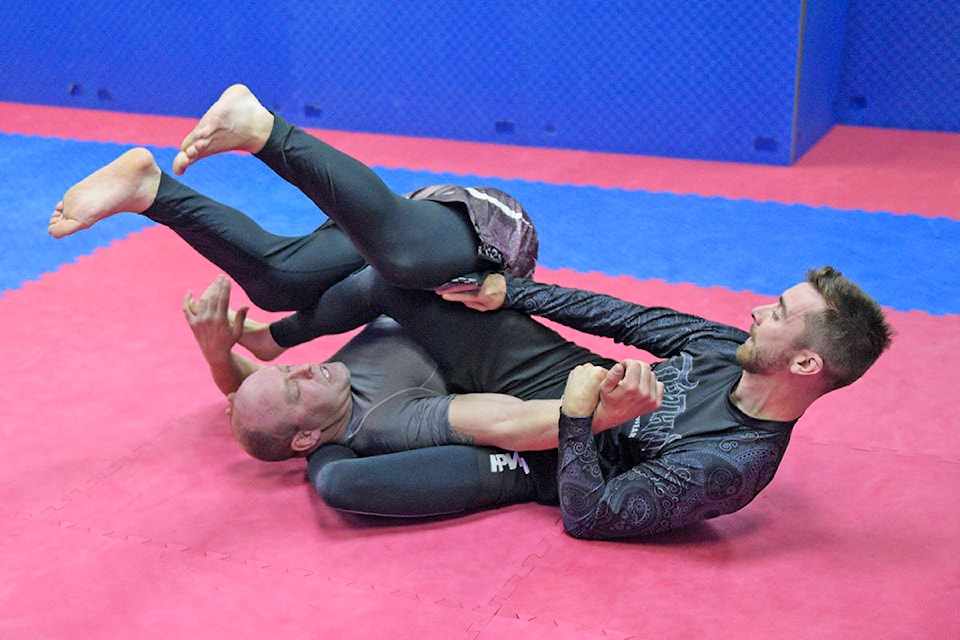The 2018 Alaska State No-Gi Submission Grappling Championships are in Anchorage, Alaska on Oct. 27 and a handful of Brazilian jiu-jitsu practitioners from Whitehorse’s Elite Martial Arts Academy will be making the trip to compete.
Instructor and co-owner Dan Hombert said a half dozen people from the gym are planning to compete.
“There might be more kind of last minute, and another guy that’s nursing his injury,” said Hombert.
Joining Hombert in Alaska will be the other two co-owners at Elite, Bobby Woodman and Sheldon Casselman, as well as Ashley Denisoff, Kyle Alexander and Ryan Lenssen.
The event is a no-gi competition, meaning athletes grapple in a rashguard — a type of shirt designed to protect against abrasions — and shorts.
“The distinctive difference is we’re not wearing the traditional gi uniform,” said Hombert. “It’s a little bit closer (resemblance) to the jiu-jitsu you would see in mixed martial arts.”
Aside from the uniform, the other big difference is the inclusion of leg locks. Depending on division, competitors will be able to use straight foot locks, knee bars and heel hooks.
“For some of our competitors, it’s going to be the first time they’re thrown into a situation where … it will be the first time they’re introduced — especially to the heel hook,” said Hombert.
Rather than creating divisions based on belt, the championships will divide competitors based on experience — a novice division for competitors with less than two years experience, an intermediate division for competitors with two to four years experience and an advanced division for competitors with more than four years experience.
Hombert said the gym has switched exclusively to no-gi training in the lead up to the competition to give everyone as much experience and preparation as possible.
“Typically, coach (Casselman) and coach (Woodman) are more no-gi coaches,” said Hombert, adding he typically teaches more of the gi classes. “In preparation for the tournament, we’ve been doing the last month all no-gi … so my duties have gone to no-gi as well.”
Aside from leg locks and the uniform, Hombert said sweat and grip can play a bigger role in no-gi grappling.
“It’s a lot slipperier. With the gi, you get lots of traction — you can hang onto collars,” said Hombert. “This one, you’re more looking to grip the back of the neck and elbows.”
Those differences also change the effectiveness and ease of application for certain techniques, both offensive and defensive.
“There’s a few that are easier, like the D’Arce (choke) and the rear naked choke, to get in no-gi,” said Hombert. “But ones like arm bars, it’s just a little bit easier for them to pull their arms out. Instead of using a more technical escape, sometimes it’s just the slippery sweat (and) you just quickly yank your arm out.”
The bonus though, said Hombert, is it helps students focus on proper technique applying submissions.
“It makes for more technical grappling in certain areas for sure,” said Hombert.
The gym earned five medals in Calgary, and Hombert said the hope is to match or best those results, but that Alaska is a bit of an unknown for the competitors.
“We’re hoping to come back with some more silver and gold medals,” said Hombert. “I’ve never grappled in Alaska. … I know they have some good black belts and a couple good MMA gyms in Anchorage, so I’m expecting the level to be pretty good.”
The tournament is a single-elimination format with novice matches lasting five minutes, intermediate matches lasting six minutes and advanced matches lasting seven minutes.
In the event a match continues to the time limit, the winner is determined by points. Points are awarded for takedowns, sweeps from the guard, passing the guard, knee on stomach, mount and back control.
The ultimate goal, though, is to submit your opponent.
“There are certain things people excel at because of body types a lot of times,” said Hombert.
Taller competitors tend to utilize triangle chokes — trapping the head, and often arm, of the opponent with the legs — while shorter competitors lean towards techniques like the Kimura — a shoulder lock.
Hombert said that while that’s the general idea, winning means taking what is available.
“Basically you want to be able, when someone makes a mistake, (to) capitalize with whatever submission is presented.”
The event also has rules in place to prevent stalling, something that can sometimes happen if a competitor gets a good position early in a match.
“It sounds like they’re putting a little more of a focus on it because there is a tendency sometimes with wrestlers, they get a takedown and they stall out a little bit because they have good balance but their technical jiu-jitsu isn’t quite as good,” said Hombert. “That’s good for us. We do lots of takedowns, so if we get stood back up, we feel comfortable on our feet. I don’t think our gym would ever be considered a stalling type of gym, so I think we’re pretty happy.”
The championships start 9 a.m. Alaska Daylight Time on Oct. 27 at Lumen Christi High School in Anchorage, Alaska.
Contact John Hopkins-Hill at john.hopkinshill@yukon-news.com
